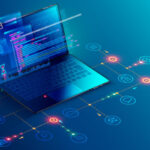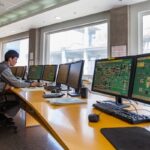We explain what hardware is and the generations of hardware that exist. Also types of hardware and examples of hardware, and the difference between hardware and software.

What is hardware?
In computing and information technology, it is known as hardware (from English hard, rigid, and wareproduct, merchandise) to the set of tangible, material components of a computer or computer system. It includes all mechanical, electrical and electronic parts, without considering the programs and other digital elements that are part of the software.
The term hardware It was used in English from the 15th century to designate utensils and tools made of hard metals. At the moment, hardware It is also used with the meanings of 'hardware, 'weapons' and 'set of metal trinkets'.
With the emergence of computers in the 1940s, it began to be called hardware to the physical components of the machine to distinguish them from the logical components.
the word It is used in Spanish and other languages without translation. In the case of Spanish, several equivalent terms and expressions have been proposed, without much success: equipment, computer equipment, components, physical support.
See also: Interface
Hardware history
Since the first computer systems, hardware has undergone important changes, in order to obtain faster computers capable of developing a greater diversity of tasks. Taking into account the most significant advances, at least four generations of hardware are distinguished:
- First generation (1945-1956). They were calculating machines that operated through vacuum tubes.
- Second generation (1957-1963). Transistors were invented, thanks to which the overall size of computers was greatly reduced.
- Third generation (1964-1971). The first integrated circuits were designed, printed on silicon chips, which allowed greater speed and effectiveness in information processing.
- Fourth generation (1971-1981). Microprocessors emerged, which allowed the creation of the personal computer (PC).
To these four generations, is sometimes added a fifth generation (1982-1989) corresponding to the development of parallel computing systems, capable of executing many operations simultaneously. It was a project that did not obtain the expected results and was abandoned.
Hardware Types

According to the task it performs, hardware is classified into five main categories:
- Processing hardware. It is the heart itself of the computer, where its ability to perform logical operations resides, that is, its calculations. It corresponds to the Central Processing Unit (CPU) o The motherboard or motherboard can also be considered as part of the processing hardware (motherboard), which connects all the components.
- Storage hardware. It is the system memory. These are units that allow information to be stored, both on internal media within the machine and on removable and portable media. The main component of this type is random access memory, better known as RAM (acronym in English). Random Access Memory).
- input hardware. They are devices that allow information to be entered into the system. They can be integrated into the machine or removable. The keyboard, mouse, microphone and scanner are part of this type of device.
- Output hardware. They are devices similar to input devices, but they allow information to be extracted from the system. These types of devices include the printer and speakers.
- Input and output hardware. They are those devices that combine the input and output functions of information from the system. Hard drives and USB sticks are input and output components.
Hardware can also be classified based on its importance. In this case, two groups are distinguished:
- Critical hardware. It is the one without which the computer cannot function. It includes the motherboard, CPU, RAM, graphics card and power supply.
- Non-critical hardware. They are the components that, although necessary, are not essential for starting the computer. The hard drive and, in general, the input and output devices belong to this category.
Hardware examples
Some hardware examples are:
- The motherboard. It is a printed circuit on which the rest of the computer components are connected. The characteristics of the motherboard determine the characteristics of the rest of the components (processor technology, type of RAM, graphics card performance, etc.). A series of components called buses connect the components to each other.
- The processor. It consists of an encapsulated chip (integrated circuit). Performs simple arithmetic and logical operations and binary logic operations; In addition, it controls access to memory. It has a socket that allows it to be connected to the motherboard. AMD and Intel are the main processor manufacturers.
- RAM memory. It is made up of a set of chips that store information, which the processor can quickly access. It is called random access memory because it can read or write information located in any position, without the need to follow a correlative order.
The information in RAM remains temporarily stored, that is, it is lost when the computer is turned off. - storage unit. It is the device that stores information. Unlike RAM, the storage unit stores information permanently. There are two types of storage units: hard drives or rigid drives (hard disk driveHDD) and solid state drives (SSD).
- The HDDs older, are made up of one or more rotating metal platters, on which a magnetic head reads or writes information as the computer is used.
- SSD drives more modern, do not have mechanical parts: the information is stored in chips that use flash memory. This technology allows you to read and write information located in different positions at the same time. In this way, they are much faster than hard drives.
- The graphics card or video card. This component processes data from the CPU and converts it into visual information that can be observed on a monitor. In order to alleviate the work of the CPU, the graphics card has its own processor: the graphics processing unit (GPU). It also has its own RAM memory: the VRAM. In addition, it has a component that converts digital signals into analog signals, so that they can be read by a monitor.
- The energy source. It is responsible for receiving alternating electrical current and transforming it into direct current, which powers the internal devices of the computer. The source is also responsible for filtering and distributing the voltage that the devices require to operate, since not all of them require the same amount of volts.
Hardware and Software

For hardware to work, it needs to be told how to do it. This is what the software, the set of intangible components of a computer. Both the operating system and the programs and the data processed by the CPU are part of the software.
Hardware and software are, therefore, aspects of the computer that operate together, since the first supports the second and the latter allows us to control the way in which it operates and the objective of the first.
Free hardware
For some time now, in parallel with advances in the area of computing, free hardware has been gaining momentum. In general, free hardware is that which can be modified and used freely. In practice, these are hardware devices whose specifications and diagrams are publicly accessible (either for a fee or free of charge).
As with free software, the use of free hardware means sharing information about developments that have been based on it, regardless of whether it is commercially exploited or not. There are different types of free hardware licenses, which establish the specific scope of hardware use.
Currently, there are several free hardware initiatives. Many are collaborative projects, aimed at the development of some new technology (high-performance processors, devices with lower environmental impact, smart printers). Others are part of educational or social programs (devices created for teaching computer science, low-cost computers).
References
- “Computer hardware”, on Wikipedia.
- “Computer generations” in Columbia University Computing History.
- “Essential concepts of computers” at Tecnológico de Monterrey – Virtual learning center.
- “Statement of Principles 1.0”, in Open Source Hardware Association.





